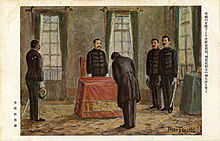Japanese red cross
The Japanese Red Cross ( Japanese 日本 赤 十字 社 , Nihon Sekijūji-sha ; short form 日 赤 , Nisseki ) is the National Red Cross Society in Japan according to the Geneva Agreement and as such part of the International Red Cross and Red Crescent Movement , headquartered in Tōkyō . Honorary President is the respective Empress, Honorary Vice-Presidents are the Crown Prince couple and other members of the Imperial House.
Overview

During the Satsuma Rebellion in 1877, the member of the Council of Elders of the Government Sano Tsunetami (1822–1902) and Ogyū Yuzuru (1839–1910) brought together a group of volunteer helpers to care for the wounded, with whom the Hakuai- sha ( 博愛 社 ), in German about "Philanthropic Society", was founded. When Japan acceded to the Geneva Convention in 1886 , the Hakuren-sha renamed itself the “Japanese Red Cross” the following year and was accepted as a member by the International Red Cross. - The activities of the Japanese Red Cross are regulated by Law 309 of August 14, 1947.
The Japanese Red Cross operates 104 medical facilities, 19 facilities for nurses and other personnel, 234 facilities under the blood donation program, and 29 charities. More than 65,000 people are employed in these facilities.
The current president is Tadateru Konoé . The society currently has 9.6 million members and is supported by 120,000 corporate members.
tasks
The tasks are divided into the following areas:
- Use in emergencies and catastrophes in Germany with special consideration of the earthquake risk.
- Medical services: The JRC operates 92 hospitals with more than 20 beds, plus numerous other facilities. Most of the hospitals are equipped for disaster relief.
- Security services: first aid training, assistance on the water and in the snow.
- Welfare services for the rapidly aging population.
- Running a blood donation program in which around 5 million Japanese people donate blood each year.
- Maintenance of six colleges and 17 training centers for nurses and auxiliary staff.
- Establishment and promotion of the youth organization "Shōnen Sekijūji" ( 少年 赤 十字 ), which has around 3 million members.
- Development and promotion of the volunteer helpers in the context of the "Sekijūji Hōshi-dan" ( 赤 十字 奉 仕 団 ). To this end, a campaign to recruit new Red Cross helpers is organized every year in May.
- international activities
structure
The company is based in Tokyo, with headquarters in each of the 47 prefectures. The management has 223 members, the society is divided into the following departments: Administration, Operations Department, Welfare Department, Blood Services Department and Public Relations.
Funding (2013, in billion yen)
| Area | revenue | expenditure | difference |
| General | 68 | 64 | 4th |
| Medical institutions | 977 | 970 | 7th |
| blood donation | 167 | 177 | −10 |
| Welfare | 18th | 14th | 4th |
Others

The Japanese Red Cross honored the camp commandant, Matsue Toyohisa ( 松江 豊 寿 ; 1875–1952), with a memorial stone for his dealings with the German prisoners of war in the Bandō camp (today located within the city of Naruto ).
Remarks
- ↑ The coat of arms shows the red cross, enclosed by a wreath made of bamboo, emperor paulownia and is crowned by a phoenix.
- ↑ Ogyū Yuzuru ( 大 給 恒 ) was called Matsudaira Noritaka until 1869 and was a daimyō of Okutono.
literature
- Suzuki, Toshihiko (Ed.): Nihon Sekijuji-sha . In: Nihon daihyakka zensho (Denshibukku-han), Shogakukan, 1996.
- Lewis Bush: Japanalia. A Concise Cyclopaedai. Tokyo News Service, 1970.


